This series of images were provided by Malin Space Sciences System on their public website, as part of a collection of more than 50.000 pictures originating from the Mars Global Surveyor satellite's camera.
The appearance of these gullies in the Gorgonum Chaos region of Mars suggests that liquid water has seeped out of the surface recently:
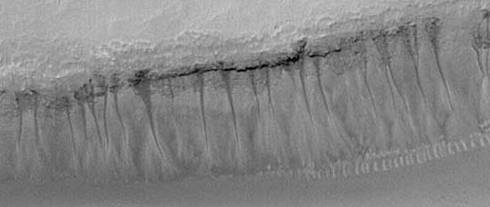
|
These landforms were found in the in the south polar pitted plains, at extremely cold latitudes. Despite the fact that this would be an unlikely place for liquid water, gullies with very sharp, deep, v-shaped channels are seen, according to NASA.
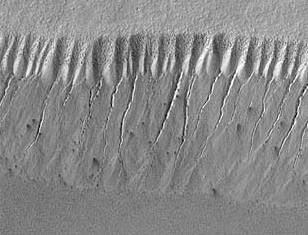
|
Martian gullies on the northern wall of a meteor crater. The image on the right is a close-up of the inset area on the left. Sharp relief on the channels and deposits indicate many individual water and debris flow events have occurred recently here.
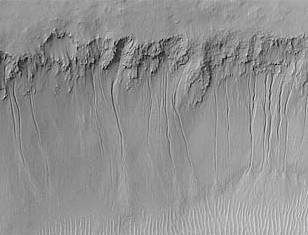
|
More than 14 channels, each nearly 1 kilometer (0.6 miles) long, running down the south-facing slope of the Nirgal Vallis wall. The apron deposits and sand dunes in this image are uncratered, suggesting a very young geological age, according to NASA.
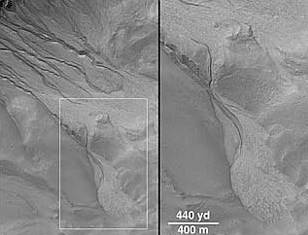
|
This mosaic shows about 20 different gullies coming down the wall of a trough in the Sirenum Fossae/Gorgonum Chaos region. The channels and aprons only occur on the south-facing slope of this valley, according to NASA.
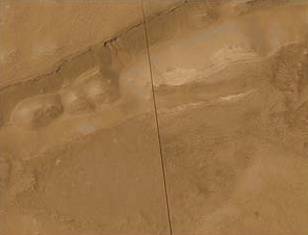
|
This example, from a crater in the northwestern Elysium Planitia, shows a contrast between liquid seepage-related landforms and dry slope erosion processes. Deep gullies are seen on the left; a dry erosional slope on the right.

|
Narrow gullies eroded into the wall of Newton Crater are hypothesized to have been formed by flowing water and debris flows. Hundreds of individual water and debris flow events might have occurred to create the scene shown here.
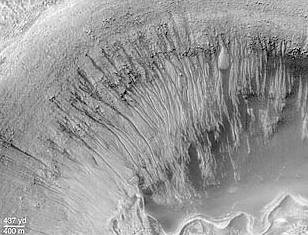
|
Liquid water in the recent past likely formed distinct gullies and deltas on Mars, scientists said Thursday. The discovery bolstered hopes that the planet could harbor simple life and someday host human colonists.
"The presence of liquid water on Mars has profound implications for the question of life not only in the past, but perhaps even today," NASA Associate Administrator Ed Weiler told reporters.
Water seepage and surface runoff could have formed more than 100 rare landforms found along steep cliffs "a million years ago, a thousand years ago, perhaps yesterday," Weiler said.
Planetary geologists made the discovery by combing through recent photos taken by the Mars Global Surveyor spacecraft. The images show the smallest features ever observed from Martian orbit, about the size of a sport-utility vehicle.
"These are new landforms that have never been seen before on Mars," principal investigator Michael Malin said. "We see features that look like gullies formed by flowing water and the deposits of soil and rocks transported by these flows."
Mostly in high latitudes and the southern hemisphere, the sites include gullies and alluvial fans within the walls or rims of pits, valleys and impact craters. More than 90 percent occur south of the equator and most occur on slopes that face away from the sun.
"We were quite surprised and confused by it. It didn't fit our model of what Mars is like," said Malin of the Surveyor data. Malin Space Sciences operates a camera onboard the NASA satellite, which has orbited Mars since 1997.
Scientists have long thought Mars' surface coursed with water billions of years ago, based on evidence of liquid erosion and signs of ancient channels and seas. But the water all but disappeared as the planet cooled and its atmosphere thinned.
Water may have once been abundant on Mars, then disappeared as the planet cooled and its atmosphere thinned.
Water is known to exist today as ice in the northern polar cap and as vapor in faint clouds. But the presence of liquid water near the surface could strengthen the theory that life exists or once existed on Mars.
"If life ever did develop there, and if it survives to the present time, then these landforms would be great places to look," Weiler said.
Liquid water on Mars would also make travel to the planet easier. Astronauts could convert water into hydrogen and oxygen, using both as rocket fuel and the second for breathing gas.
Ken Edgett, the co-author of the Science Magazine report, was at first skeptical that water formed the unusual features.
"I was dragged kicking and screaming to this conclusion," but the visual evidence linking groundwater discharges as the cause was too strong, he said.
The water is thought to exist about 100 to 400 meters (300 to 1,300 feet) below the surface. Malin estimated the volume of a typical flow at about 2,500 cubic meters (90,000 cubic feet), "which would fill half a dozen or so swimming pools."
Still some troubling questions remain. Why do the discharges take place in the coldest areas on Mars, near the poles and on slopes facing the poles?
Malin suggested that that the groundwater could be some exotic salty brine with unknown physical properties.
I already mentioned in this website that NASA scientists obviously disregard some obvious data and facts. First, for example, 1976 Viking temperature data measurd on the landing site showed an average temperature of minus five Celsius degrees but NASA omitted to remind that it was measured several feet up in the atmosphere and too many scientists thought it was the ground temperature.
Second, only pure water freezes under zero Celsius degree. If the water is salty, for example, it might well freeze only under minus 35 Celsius degrees, without any extraordinary high concentration in salt. Dr. Malin is looking in the right direction, but there is no necessity to look for 'salt with unknown physical properties'. Those among us who throw salt on the snowy roads in winter know.
NASA plans to launch an orbiter in 2001 that will examine the seepage sites for evidence of water-related minerals. The agency is considering two options for an unmanned mission to Mars in 2003.
The Mars Polar Lander was to search for Martian water in 1999. The doomed robot ship was to dig beneath the surface and study the atmosphere, but went silent as it entered the atmosphere of the planet.
I wrote all the above lines in November 2001. In 2003, this turned even more interesting.
Before 2001, the larger public generally believed that there is no more water at all on Mars, or even that there never was any, whereas for scientists, it was already almost consensual that there had been water on Mars in the past and its "absence" meant simply that water was "hidden" somewhere, for example mixed with the soil and frozen as in Siberia's permafrost. The discoveries in 2001 indicated that this water could occasionally flow in liquid form.
In 2003 the presence of vast quantities of water suspected by the most daring Mars scientists was confirmed by spectrometry measurement by the Mars Odyssey space probe as soon as it started its mission. There are indeed vast quantities of water in the underground, and surprisingly largely distributed on the surface of planet as previously imagined. It was also discovered that Southern polar cap which was thought to be of frozen CO2 is actually constituted of frozen water which was only hidden with a layer of few meters of frozen CO2. It was previously estimated that only the Northern polar cap is made of cold water.